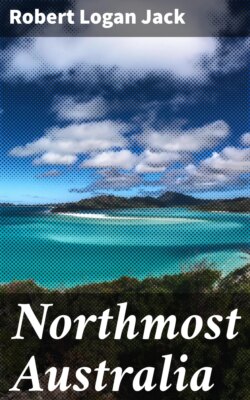Читать книгу Northmost Australia - Robert Logan Jack - Страница 43
На сайте Литреса книга снята с продажи.
CAPTAIN EDWARDS
Оглавление"On the 4th September, at half-past 3 in the afternoon, we stood out of the north entrance of the sound i.e., out of FLINDERS PASSAGE into PRINCE OF WALES CHANNEL.—R. L. J.]. Before 5, we saw a reef extending from the N. to the WNW., and which appeared to run in the latter direction, or more to the westward [NORTH-WEST REEF], On the edge of this reef, we had 3¾ fathoms of water, and after hauling to the southwest we soon deepened our water to 5 fathoms. Besides Mountainous and West Islands, seen by Lieutenant Bligh, we saw several other islands between the north and the west, one of which I called HAWKESBURY ISLAND...
"In the evening, we saw the NORTHERNMOST EXTREMITY OF NEW SOUTH WALES [really the hump of land west of the mouth of the Jardine River.—R. L. J.], which forms the south side of Endeavour Straits. At night the boats took each other in tow and we steered to the westward. "It is unnecessary to retail our particular sufferings in the boats during our run to TIMOR, and it is sufficient to observe the company suffered more from heat and thirst than from hunger, and that our strength was greatly decreased. We fortunately had good weather."
Surgeon Hamilton states that "we ascertained the latitudes with the greatest accuracy and exactness," a claim which he would hardly have made on his own account, and which, it may be conjectured, he simply copied from the Captain's log, of which the latter evidently made only a short abstract for his reports to the Admiralty. Nor, I imagine, would the Captain himself have made such a claim unless he had been provided with a sextant. The Captain gives the position of MURRAY ISLANDS as 9° 57' S. and 216° 43' W = 143° 17' E.; and the WRECK REEF is also given in his table, but the figures are left blank. The Surgeon gives the same position to the
Murray Islands, and fills in the blank at the Wreck Reef with the figures 11° 22' S. and 216° 22' W. = 143° 38' E. The inference is that he copied from the Captain's log, and set down, without question, data regarding which the Captain himself had some doubt, so that he omitted them from his report.
After many attempts at plotting from Hamilton's data, on various hypotheses as to his meaning, I can no more make head or tail of the positions of the islands and other landmarks mentioned by him than could Flinders, although I had the advantage of more complete charts than were accessible to, or made by, Flinders. One hypothesis, suggested by the Surgeon's tale, which I tried by all possible tests, was that the boats went through Endeavour Strait; but this is flatly contradicted by the Captain's narrative. I am satisfied, therefore, that Basil Thomson is correct in supposing that the "Sound" referred to by both Captain and Surgeon was neither Endeavour Strait as a whole nor the passage between Entrance Island and Prince of Wales Island, but the strait between Horn and Wednesday Islands, now known as Flinders Passage. Edwards thus anticipated Flinders (in the "Cumberland") by twelve years. The island named LAFORY'S was, no doubt, as suggested by Basil Thomson, HORN ISLAND, and the "wolves" which Edwards saw and Hamilton heard must have been DINGOES. This is the only mention of the dingo as an indigenous inhabitant of the Torres Strait Islands which I have met with.
Edwards, then, took the "Pandora's" boats through the FLINDERS PASSAGE, and was actually its discoverer, rounded the north end of HAMMOND ISLAND [1] entered the PRINCE OF WALES CHANNEL and passed through its western half. The first to enter the Prince of Wales Channel was GONZAL, in the "Rijder" in 1756. BLIGH, in the "Bounty's" launch, in 1789, was the first to traverse it from end to end.
Endeavouring to maintain a westerly course through the Channel, Edwards encountered the "NORTH-WEST REEF," and was forced by it southwards, nearly to Good Island, before he found an open sea by which he could make westward for Timor.
On emerging from the strait, a last glimpse of Australian land was obtained, S. and by E. Both Edwards and Hamilton refer to this as the northernmost extremity of New South Wales, Edwards adding "which forms the south side of Endeavour Straits." The land visible from the observer's position could not have been Cape York, which would be shut out by the high Prince of Wales Island, and must have been the blunt promontory west of the MOUTH OF THE JARDINE RIVER.
The provisions with which the boats left the scene of the wreck were inventoried as "a small barrel of water, a keg of wine and some
[1) He gave the name of Hammond to some island hereabouts, but his narrative does not make it clear that it was the island now known by this name.]
biscuit." The ship's cat was saved from the wreck. The scanty fare was supplemented by shellfish while the party sojourned among the Torres Strait islands.
. The survivors got a passage from Koepang, in TIMOR, to Batavia and thence to Europe. At the Cape of Good Hope, Edwards and his prisoners were transferred to H.M.S. "Gorgon." They arrived at Spithead on 19th June, 1792. The prisoners were tried by court martial, when six were condemned to death (18th September), and three were executed.
It is beyond the limits of our task to relate the whole story of the mutiny, one of the most tragic and romantic in modern history; but the reader who desires to pursue the subject for its own inherent interest may refer to Sir John Barrow's little book, The Mutiny of the "Bounty" (the World's Classics, No. CXCV, 1914).
